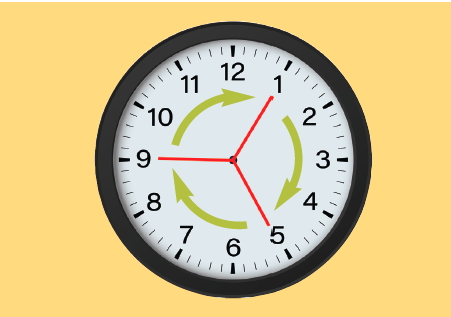Pay attention to sleep, nutrition, exercise, and your personal life.
- Night Council leadership saw a need to help night shift teammates have healthier lifestyles.
- The council addressed four core needs of shift workers: sleep, nutrition, exercise, and commitments outside of work.
- A healthy night shift team enhances staff and patient safety via increased productivity and engagement.
According to the U.S. Bureau of Labor Statistics, 16% of workers are on a night or an evening shift. In a hospital setting, that percentage is even greater, because illness and life and death don’t stop with a clock. Approximately 30% of the nursing workforce is on night shift. The 24-hour nature of healthcare requires people to take shifts that put them at odds with most of the world in addition to their own internal body clocks.
The deleterious effects of shiftwork can take hold at the genetic, physiological, and psychological level, which may have deadly consequences for a patient. These truly essential night shift workers need guidance to navigate their schedules.
At Hackensack University Medical Center, a large, academic acute care hospital, which has received multiple Magnet® designations from the American Nurses Credential Center, the Night Council plays an essential role in the shared decision-making structure. In alignment with the organization’s nursing strategic priority to advance a culture of excellence with the Magnet principles, the council supports the needs and concerns of night shift workers, including new nurses who typically start out on the night shift.
Council leadership, all experienced frontline nurses, heard from members about the ongoing challenges they experience to find a work–life balance and practice self-care. Understanding the uniqueness of working the night shift, the leaders applied the concepts of Watson’s Theory of Human Caring and the organization’s nursing professional practice model to identify a strategy to support their peers. A subgroup of clinical nurses conducted a literature review to identify core topics that promote well-being, and to develop a resource for night shift team members. The Night Council has since led, created, and disseminated a Night Shift Survival Guide that addresses four core shift worker needs: sleep, nutrition, exercise, and commitments outside of work.
Sleep
One of the most challenging aspects of surviving the night shift is managing sleep. Night shift workers routinely function with chronic sleep deprivation and disruption to their circadian rhythms, with negative effects to their health and productivity. Many studies have documented the physical and psychological effects of chronic fatigue, including an increased risk for several health conditions (such as diabetes, obesity, hypertension, and cancer) that can shorten their lifespans.
Sleep deprivation and prolonged fatigue result in decreased attentiveness and focus, as well as poor task performance. These conditions also can significantly increase the occurrence of medical errors, placing patients at risk. Drowsy driving and all of its associated dangers remain a major concern for night shift workers. Driving home after working a night shift with chronic sleep deprivation has been compared to driving under the influence of drugs or alcohol. In 2003, the state of New Jersey, where our organization is located, enacted the Drowsy Driving Law (also called Maggie’s Law), which makes it a criminal offense to drive while going without sleep for 24 hours. This statute states that knowingly driving while in a state of fatigue is an act of recklessness.
Many night shift workers report the “turnaround” day (working a night shift and having the following night off) as the most difficult. Some describe it as a “lost” day off. If a night shift worker sleeps more than 7 hours, they feel as though they’ve lost the day. However, if they don’t sleep, they become severely fatigued because they may have been awake for more than 24 hours.
Adapting to working the night shift can present challenges, but finding tactics that work best for you will help ensure you manage sleep safely and effectively. (See Effective sleep management.)
Effective sleep management
Quality sleep is key to successfully managing night shift work. Experimenting with different strategies and observing how your body responds can help you find the best approach. Consider the following sleep routine options based on your individual needs and preferences.
- Take an afternoon nap the first night back to work after one or more nights off.
- When you have consecutive nights off, return to a typical routine of being awake all day and sleeping during the night.
- Keep an owl-like routine—on nights off, remain awake until 2:00 am or later and sleep until 11:00 am or later.
- If you’re naturally more alert and productive at night, maintain a night schedule regardless of your work schedule.
- Anchor sleep within the same 4- to 5-hour period each day of the week. For example, if you work night shift and want to be awake in the daytime during your days off, make your anchor 9 am to 1 pm (sleep from 9 am to 5 pm on days you work and from 5 am to 1 pm on days off). This approach eases transitions between days on and off.
The following suggestions can help improve sleep quality:
- Avoid caffeine 7 hours before sleep.
- Take natural sleep aids, such as chamomile, valerian, melatonin, or passionflower.
- Try aromatherapy (lavender, cedarwood) baths.
- Invest in blackout curtains, eye masks, headphones, or white noise machines.
- Use smartphone apps that temporarily block unimportant incoming calls.
- Limit electronic and social media use at least 30 minutes before bed.
Sources: Bustos-González, Sheehan et al, Shin et al
Nutrition
Night shift workers have a higher incidence of cardiovascular disease, GI disturbances, obesity, and metabolic disorders. Diabetes occurrence runs particularly high among these workers. In addition, interruptions in behavioral rhythms can increase the risk for mental health disorders, such as anxiety and depression. Proper nutrition can help night shift workers reduce these health risks.
Night shift workers frequently alter mealtimes to accommodate their work schedules. In fact, meal timing can be key to preventing and managing many health concerns. Chrono-nutrition, a field that studies the relationship between circadian rhythms and nutrition, has shown that meal irregularity disrupts circadian rhythms by interfering with digestive and metabolic processes, which place night shift workers at increased risk of cardiometabolic disease. Adhering to time-restricted eating schedules may improve cardiometabolic health by decreasing blood pressure and HbA1c in populations with higher risks. (See Time-restricted eating.)
The types of food you eat also play a role. Research shows that carbohydrate oxidation is highest in the morning and lowest in the evening. Insulin resistance, however, is lower in the morning and increases in the evening. This suggests that increased carbohydrate and caloric load in the morning and reduced intake in the evening can lead to improved health outcomes. Establishing a meal pattern can aid energy regulation and normal health processes. For example, consider eating a high protein meal before or at the beginning of your shift to help prolong energy levels.
Other healthy options include fruits, vegetables, nuts, protein shakes, and cheese with whole grain crackers. Eating a light snack or adhering to a time-restricted eating schedule as opposed to consuming a full or unscheduled meal has been shown to improve alertness as well as to reduce complaints of headaches and dizziness. Avoid eating heavy meals and difficult-to-digest foods during your shift, including foods high in sugar and fat. Resist using sugary foods for an energy boost; the energy drop that follows will increase fatigue for the remainder of your shift.
Dehydration can affect mental performance and motor coordination. Night shift workers should consume water and sugar-free drinks regularly throughout their shift. Many night shift workers rely on high caffeine consumption, but caffeine can cause sleep disturbances, which may negatively impact circadian rhythms.
Exercise
Learning when to eat and sleep while maintaining an alternating 12-hour shift schedule can prove difficult, leaving other essential healthy habits, such as physical activity, overlooked and undervalued. Exercise helps to reduce stress and anxiety, countering the harmful effects of shift work.
Being physically active and participating in something you enjoy is better than doing nothing at all. Any repetitive body movement that raises the heart rate and promotes muscle development can be considered exercise. Current guidelines from the World Health Organization recommend a minimum of 150 minutes of moderate-intensity physical activity each week. Any successful exercise endeavor requires time management, nutrition, and ample sleep. Ultimately, physical activity can enhance sleep quality, which boosts exercise and workplace performance.
Choosing to exercise before, during, or after work may depend on age, ability, gender, hormonal status, and available staffing. Exercising before work can boost your resting metabolism during your shift and also mediate hormonal imbalances due to disrupted sleep–wake cycles. It also can enhance workplace performance. If the only available time to exercise is after work, consider more weight and resistance training and fewer cardiovascular routines. Weight training may be preferable to cardiovascular workouts due to its higher excess post-exercise oxygen consumption levels, which result in a longer period of high metabolic rate and caloric consumption after a workout. Given the ultimate need for ample time to sleep, nurses who exercise after work, should maintain a routine that yields the greatest metabolic benefit. Further research will help identify the optimal time for shift workers to exercise.
Beneficial physical activity is also possible while at work. Dedicated breaks with organized groups using pre-recorded videos can increase exercise consistency and create a sense of motivation and camaraderie among participants. If staffing levels can’t accommodate ample breaks, taking the stairs, standing when charting, and collaboratively using pedometers among coworkers encourages intentional behavioral changes alongside direct patient care.
Commitments outside of work
Every nurse will find themselves with a lot to do on their days off. Getting these tasks completed is especially challenging for night shift workers because they live out of synch with the rest of the world. Stay organized by using to-do lists and calendars. Plan the week ahead of time to combine chores and activities, which will maximize your free time and help you avoid delaying tasks when you’re too tired or already on your way to your next shift. Don’t overschedule yourself on days off; getting proper rest is more important than getting to the post office or cleaning out the attic.
Remember, you don’t have to do everything yourself. Delegate some responsibilities (cleaning, laundry, shopping) to other members of your household. They’ll be glad to do the dishes if it means extra time with you. Prioritize quality time with family and friends. Those moments are more valuable to your well-being than a clean kitchen or picking up an extra shift.
Nursing is a stressful occupation, especially during these past few years. Make an effort to leave work at work. Mentally disconnect from your job so you’re present for your life at home. Focus on the positive—when it’s time to return to work, remind yourself why you became a nurse.
Adapt successfully
Night councils give a voice to the specific concerns of those who work night shift. Every organization should establish such a group. In addition, administrators must regularly examine the well-being of their night staff and make any needed improvements. A healthy nursing team increases productivity and engagement and improves patient outcomes.
Working the night shift poses inherent challenges that go beyond the clinical demands of being a bedside nurse. However, with the proper tools, you can thrive personally and professionally. As nurses, we recognize that we can’t do our jobs without the partnership of respiratory therapists, patient care technicians, pharmacists, environmental service workers, security guards, and dietary aides who also work overnight. They, and those in professions outside of healthcare who keep the world running after dark, can benefit from knowledge and skills that help them adapt to shift work.
The authors work at Hackensack University Medical Center in Hackensack, New Jersey. Daniel E. Elmowitz, Terri Spirito, Lucia Alves, Cynthia Savastano, Denise M. Sepulveda, and Margaret Hopkins are staff RNs. Bridget Wertz is the Co-Magnet Program Director.
American Nurse Journal. 2023; 18(9). Doi: 10.51256/ANJ092355
References
Alaska YA, AlYahya B, AlFakhri L, AlHarbi B, Alkattan F, Alhayaza RM. Emergency medicine personnel’s preparation, performance and perception of their night shifts: A cross-sectional study from Saudi Arabia. Adv Med Educ Pract. 2022;13:167-75. doi:10.2147/amep.s339063
Bustos-González L. Shift work–related health problems: Causes, effects, and light-based interventions. Sleep Sci. 2020;13(suppl2):23-30. doi:10.5935/1984-0063.20200009
Charlot A, Hutt F, Sabatier E, Zoll J. Beneficial effects of early time-restricted feeding on metabolic diseases: Importance of aligning food habits with the circadian clock. Nutrients. 2021;13(5):1405. doi:10.3390/nu13051405
Chellappa SL, Qian J, Vujovic N, et al. Daytime eating prevents internal circadian misalignment and glucose intolerance in night work. Sci Adv. 2021;7(49)eabg9910. doi:10.1126/sciadv.abg9910
Davis R, Bonham MP, Nguo K, Huggins CE. Glycaemic response at night is improved after eating a high protein meal compared with a standard meal: A cross-over study. Clin Nutr. 2020;39(5):1510-16. doi:
10.1016/j.clnu.2019.06.014 D’Souza G. Should you do cardio or lift weights? Medical News Today. July 27, 2023. medicalnewstoday.com/articles/323922
Flahr H, Brown WJ, Kolbe-Alexander TL. A systematic review of physical activity-based interventions in shift workers. Prev Med Rep. 2018;10: 323-31. doi: 10.1016/j.pmedr.2018.04.004
Gabriel BM, Zierath JR. Circadian rhythms and exercise—Re-setting the clock in metabolic disease. Nat Rev Endocrinol. 2019;15(4):197-206. doi: 10.1038/s41574-018-0150-x
Governors Highway Safety Association. Drowsy Driving Laws: New Jersey. 2019. bit.ly/44OmngX
Lawson Carney M. The hidden shift: How do night shift nurses learn to adapt to circadian disruption. J Nurses Prof Dev. 2013;29(6):316-20. doi:10.1097/nnd.0000000000000016
Liao HX, Zou H, Pang J, Liu HH. Relationship among anxiety, depression, social and self-efficacy in night-shift nurses. Signa Vitae. 2023;19(1):117-22. doi:10.22514/sv.2021.135
Manoogian ENC, Zadourian A, Lo HC, et al. Feasibility of time-restricted eating and impacts on cardiometabolic health in 24-h shift workers: The Healthy Heroes randomized control trial. Cell Metab. 2022;34(10):1442-56. doi:10.1016/j.cmet.2022.08.018
Oosterman JE, Wopereis S, Kalsbeek A. The circadian clock, shift work, and tissue-specific insulin resistance. Endocrinology. 2020;161(12): bqaa180. doi:10.1210/endocr/bqaa180
Salle B, Weaver SH, Martinez J, Maina N. Night nurses and exercise. Am Nurse J. 2021;16(9):32-34.
Sheehan CM, Frochen SE, Walsemann KM, Ailshire JA. Are U.S. adults reporting less sleep? Findings from sleep duration trends in the National Health Interview Survey, 2004-2017. Sleep. 2028;42(2):zsy221. doi:10.1093/sleep/zsy221
Shin S, Kim S-H, Jeon B. Objective assessment of sleep patterns among night-shift workers: A scoping review. Int J Environ Res Public Health. 2021;18(24):13236. doi:10.3390/ijerph182413236
Simmons University. How to thrive while working the night shift. bit.ly/3OdOuPB
Smith S. 4 keys to maintain your fitness while working the night shift. Military.com. 2023. military.com/military-fitness/health/working-the-night-shift-fitting-in-fitness-Nutrition
Tucker S. Nursing, night shift, and nutrition. Am Nurse J. 2020;15(6):21-3.
US Bureau of Labor Statistics. Job flexibilities and work schedules summary. September 24, 2019. https://www.bls.gov/news.release/flex2.nr0.htm
U.S. Department of Health and Human Services. Physical Activity Guidelines for Americans. 2nd ed. 2018. health.gov/sites/default/files/2019-09/Physical_Activity_Guidelines_2nd_edition.pdf
van Elk F, Robroek SJ, Smits-de Boer S, Kouwenhoven-Pasmooij TA, Burdorf A, Oude Hengel KM. Study design of PerfectFit@Night, a workplace health promotion program to improve sleep, fatigue, and recovery of night shift workers in the healthcare sector. BMC Pub Health. 2022;22(1):779. doi:10.1186/s12889-022-13206-9
Weidenauer C, Volmer C, Scheiter K, Randler C. Weak associations of morningness-eveningness and stability with skin temperature and cortisol levels. J Circadian Rhythms. 2019;17:8. doi:10.5334/jcr.182
World Health Organization. Global status report on physical activity 2022: Country profiles. January 21, 2023. who.int/publications/i/item/9789240064119
Key words: night shift, sleep, safety, nurse wellness


















